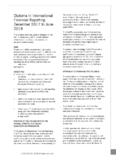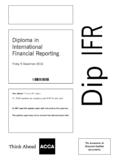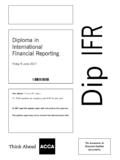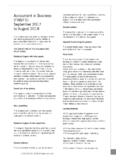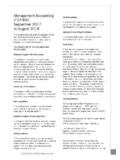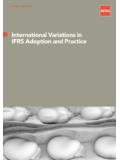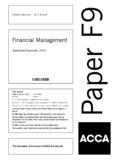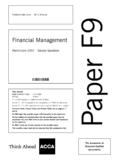Transcription of Examiner’s report - ACCA Global
1 Examiner s reportP1 Governance, Risk &EthicsDecember 2016 examiner s report P1 December 20161 General CommentsThe overall performance of candidates in this paper was generally good and it provided the opportunity for thewell prepared candidate to score CommentsThe examination consisted of the standard two sections. Section A contained one question for 50 marks andSection B contained three 25 mark questions, from which candidates had to answer is a Professional Level paper and as such candidates must be fully prepared, both in terms of technicalknowledge and exam technique. Good exam technique is essential to this paper as it is in all others.
2 As a startingpoint, the exam rubric of how many questions to answer in each section must be adhered to in order to maximiseyour chances of success. The exam is challenging enough to pass by attempting the correct amount of questionsbut becomes extremely difficult if only one question from Section B is attempted. There are very few candidatesthat will pass if insufficient questions have been answered. Similarly missing out sections of questions, whichcould add up to a significant number of marks, should also be avoided. Reasons why whole questions or parts ofquestions are not attempted are probably due to either lack of knowledge or poor time management or possiblyboth.
3 Although tuition providers and candidates may attempt to predict which syllabus areas will feature in anyparticular session, it would be extremely hazardous for candidates to come into the exam hall with large syllabusgaps in their was pleasing to see evidence of time planning on scripts, with many of the better candidates writing the time tostart and stop for each question on their scripts. However there were many cases of poor time managementdisplayed by the weaker candidates. This weakness can be corrected but does require practice. Candidates mustuse the permitted time wisely and use the mark allocation as a guide to how many points they need to question has a maximum number of marks and once this has been met then candidates cannot score anymore regardless of how much they write.
4 As a general rule at this level marks are often awarded for identificationand then application. So for a 12 mark question if you can identify six relevant points from a case and then applythem (or state why these are relevant) to the case then you should move on. Do not try to find more and do notwrite reams about just one particular point. Once your time is up on any particular question part you also need tomove on. As a general rule more marks will be scored by answering what you can from four questions then fromanswering at length only three are reminded of the exam resources available to students via the website which contain manytechnical articles, study support videos, syllabus updates and exam technique guidance which provide aninvaluable sources of information.
5 To illustrate this point the following technical articles were relevant to thisparticular paper; Corporate Governance from the inside out, The Integrated report Framework, EnvironmentalAccounting and Reporting, COSO s Enterprise Risk Management framework, Internal audit, Independence as aconcept in corporate governance and risk and environmental auditing. Future candidates are reminded to makefull use of these resources as part of their overall learning OneQuestion 1 was a typical P1 case consisting of a page and a half of information on a fictitious organisation. Inthis case the organisation was a listed company based in a country whose corporate governance regulationsrequire such companies to adopt a particular board structure.
6 Details were given as to the experience andqualifications of the directors as well as details of a world class research and development department within thecompany. A takeover offer was received for the company which valued it at twice its current market value and assuch the Chairman, investment analysts and fund managers initially wanted to accept the offer. HoweverExaminer s report P1 December 20162following discussions between the Chairman, the Financial Director and the Chief Executive it came to light thatthere were new products in R&D that once launched would increase the value of the company and as a result theoffer should be rejected.
7 Further information was then provided on the institutional investors (who predominantlyowned the company), media comments on the corporate governance regulations within the country and thestandard of corporate governance reporting of the company (a) for 12 marks required a critical evaluation of the particular board structure within the this was not well answered as many candidates interpreted this to mean state the advantages anddisadvantages of this particular board structure. Preparing a generic list of advantages and disadvantages with noreference to the case cannot score highly at this level.
8 Candidates should consider carefully the verbs used in therequirements and construct their answer (b) required candidates to reflect on the level of communication within the company and suggest measuresto mitigate the risk of communication failure for 6 marks. Generally this was well answered with many practicaland logical solutions proposed. However, as one particular board structure was mandatory in this country,suggestions of a different structure scored no (c) was again generally well answered requiring a discussion on corporate governance and the particularagency problems the Chairman might face. Many candidates picked up the relevant information from the caseand scored the majority of the 10 marks on (d) of the case study typically requires an answer in a particular format whether this is a letter, email,press release, draft presentation etc.
9 And four professional marks are available in total for flow, persuasiveness,tone and format. In this particular case, a letter from the Chairman to the shareholders to be included in the nextannual report was required. Candidates should ensure that they understand the audience and write theirresponse appropriately in order to maximise these professional marks. For further hints and tips on where moremarks can be gained on this area please see(d) (i) The first part of the letter for 10 marks required a discussion on the potential of corporate governancereporting to meet the information needs of the shareholders.
10 In general this was not well answered. Somecandidates included an explanation of whether the company should accept or reject the takeover offer which wasnot required and so scored no marks and wasted significant time. Other candidates wrote about corporategovernance in general as opposed to corporate governance reporting and those that did write about corporategovernance reporting were often too narrow in their answer. Candidates are reminded to plan their answers astwo or three minutes spent planning could have avoided these common errors and enabled more marks to begained(d) (ii) The second part on institutional investors was by comparison well answered with many candidates scoringthe majority of the 8 marks on TwoThis case concerned a fund manager working for an investment company looking after the portfolios of wealthyprivate clients.
